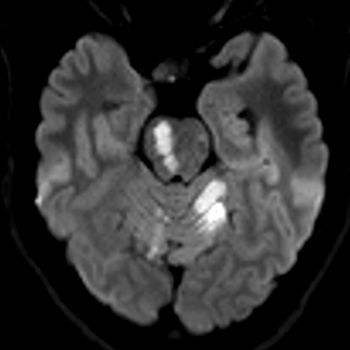Keywords
Bilateral Internuclear ophtalmolegia, artery dissection, vertebral artery
Abstract
Background: Internuclear ophthalmoplegia (INO) is an eye movement disorder caused by a lesion in the medial longitudinal fasciculus (MLF) located in the midbrain. Adduction paralysis of both eyes and bilateral abduction nystagmus are the main features of INO[1].
Case presentation: A 29-year-old Hispanic woman was admitted to the emergency department complaining of an intense holocranial headache lasting 9 days, associated with nausea and vomiting. She was discharged home with resolution of the headache but persistence of symptoms. However, she subsequently developed horizontal diplopia and gait abnormalities. She was readmitted to hospital because of anomalous eye movements and conjugate gaze palsy, manifested as bilateral INO. Magnetic resonance angiography (MRA) findings were consistent with dissection of the left V4 vertebral artery with multiple brain infarcts in the superior cerebellar artery territory, comprising both MLF tracts.
Conclusions: In young adults, bilateral INO is normally caused by demyelinating disease. In other patients, common causes include trauma, infections and autoimmune diseases with neurological symptoms. Vascular disease is implicated in over a third of cases.
References

Views: 1238
HTML downloads: 181
PDF downloads: 576
Published:
2019-06-12
Issue:
Vol 6 No 6
(view)










